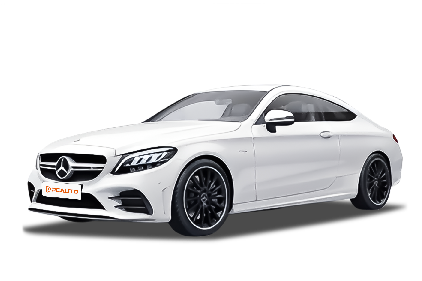Q
Does Mercedes C-Class have the automatic door-locking function?
Yes, Mercedes C-Class is equipped with automatic door-locking function, which is enabled by default. However, you can also enter the vehicle settings menu for personalized customization. Usually, when the vehicle speed exceeds 15 kilometers per hour, the door locks will be automatically activated to ensure driving safety. Additionally, after unlocking the doors with the remote key, if the vehicle isn't operated (including the doors and the trunk) within 1 minute, the system will automatically lock the doors once.
But when you park and get out of the car in daily use, if you don't manually lock the doors, the vehicle won't automatically lock. Instead, there's a reminder function, which will sound an alarm when the doors aren't locked, and you can use the remote control at this time. Moreover, if you unlock the doors with the remote control after locking the car but don't open them, the doors will be locked again within 1 minute. If you forget to lock the doors when getting out, there's no such automatic operation. This design helps prevent the keys from being left inside the vehicle.
Special Disclaimer: This content is published by users and does not represent the views or position of PCauto.
Related Q&A
Q
Which model of Mercedes C-Class is the best?
Currently in Malaysia, the Mercedes - AMG C 63 S E Performance (chassis code W206) is the most powerful C - class model. It is equipped with a 2.0L four - cylinder turbo engine and a high - performance PHEV system, with a combined output of up to 680PS and a torque of 1,020Nm, it can accelerate from 0 to 100km/h in just 3.4 seconds. This C63 S inherits AMG's racing genes and is newly added with a rear - axle electric drive, a 4MATIC+ all - wheel - drive system, and an AMG dynamic handling configuration, which significantly improves the handling. At the same time, it has an all - electric range of about 13 kilometers (WLTP standard), meeting the needs of short - distance emission reduction. Compared with the previous V8 C63 S (510PS) of the W205 generation, although the new model has sparked controversy by switching to a four - cylinder engine, it comprehensively surpasses the previous one in terms of power data and acceleration performance and is more in line with the electrification trend. In terms of price, the C63 S E Performance is expected to be priced over RM900,000 in Malaysia (subject to configuration and taxes), belonging to the top - tier performance sedan category. If your budget is a bit lower but you still pursue high performance, you can consider the C43 AMG (408PS).
Q
How to activate start-stop function of Mercedes-Benz C-Class?
The engine start-stop function of Mercedes-Benz C-Class is typically enabled by default. To verify its status or reactivate it, find the button marked with an "A" inside a circular symbol in the cabin - usually located above the left side of the gear lever - and press it to toggle the feature. For touchscreen operation, navigate to the vehicle settings, select either energy management or eco mode, and ensure the start-stop function is checked.
Some variants additionally allow control through the Mercedes me app (requiring phone connection to the car's hotspot before accessing the "Settings" menu), through the instrument cluster display (specific procedures vary by model - consult the owner's manual), or through the central console's driving computer (press the "Menu/Back" or globe-shaped button on the steering wheel to enter settings, then locate the "Engine" or "Engine Start/Stop" option).
The system automatically shuts off the engine when stationary at traffic lights or in congestion after a few seconds of brake application, restarting upon releasing the brake to accelerate or gently turning the steering wheel, thereby reducing fuel consumption and emissions.
Q
Does Mercedes C Class have a timing belt or chain?
The Mercedes C-Class uses a timing chain. The main timing drive methods for engines include timing belts, timing chains, timing gears, etc. Nowadays, most civilian gasoline vehicles use timing belts or chains. Among them, the timing chain is widely used because it requires no maintenance. The Mercedes C-Class models are equipped with timing chains. Compared with the timing belt, although it generates more noise, it has lower long-term usage costs as it doesn't need to be replaced regularly like a timing belt. Generally, you only need to check and adjust its tension every 100,000 kilometers or so. However, even though the timing chain is claimed to be maintenance-free, regular vehicle maintenance and inspections of relevant components are still necessary to ensure the normal operation of the engine.
Q
What audio system does Mercedes C Class have?
The Mercedes C-Class models are generally equipped with Harman Kardon or Burmester audio systems. Harman Kardon was founded in 1953 and is a division of Harman International Industries that specializes in producing home and car audio. Brands like BMW and Land Rover also frequently use its audio systems. It also owns several well - known brands such as JBL and AKG. The Burmester audio system was founded in Germany in 1978. As a high - end brand, it is renowned for its excellent sound quality and a pursuit of audiophile - level sound, and is a favorite among audio enthusiasts. Both of these brands can provide high - quality auditory enjoyment for passengers inside the car. For example, the 2018 Mercedes - Benz AMG C - Class Coupe is equipped with 21 speakers of Burmester and the Sound Plus function.
Q
Is Mercedes C Class equipped with ADAS?
The Mercedes C Class is equipped with ADAS (Advanced Driver Assistance System). It has reached the Level 2 driver assistance level and adopts five exterior cameras, 12 ultrasonic radars, and one millimeter - wave radar. When driving on the highway, the car - following and full - speed adaptive cruise control functions are stable, which can automatically adjust the vehicle speed according to the speed of the vehicle in front, maintain a safe following distance, and relieve the driver's fatigue during long - distance driving. In addition, the Mercedes C Class also comes with systems such as active braking/active safety systems, forward collision warning, electronic stability control, and automatic parking. For example, the active braking system can automatically apply the brakes when necessary to reduce the risk of collision; the automatic parking system can help the driver easily complete the parking maneuver. However, when facing complex road conditions such as on - ramps and road construction, the system's response ability is limited. The driver still needs to stay focused and be ready to take over the vehicle manually at any time.
Q
What suspension does the Mercedes C-Class have?
The Mercedes C-Class is equipped with multi-link independent suspensions both at the front and rear. The front and rear multi-link independent suspensions have numerous advantages in many aspects. They can effectively filter out road vibrations and bumps, providing a smoother driving and riding experience whether you're cruising on rough city streets or uneven rural roads. Additionally, this suspension setup enhances the vehicle's handling characteristics, allowing for better control during turns and maneuvers. The use of this suspension in the C-Class means that passengers can enjoy a more comfortable journey, while drivers can experience superior driving dynamics. For car enthusiasts, this suspension system is also a hallmark of the vehicle's precision engineering, which helps to improve the overall performance and reputation of the Mercedes C-Class.
Q
Does Mercedes C-Class have spare wheel?
The Mercedes C-Class doesn't provide spare tire. Instead, it's typically equipped with run - flat tires. These tires are designed to keep going even when they lose air pressure. With run - flat tires, the vehicle can still keep moving for a certain distance after the loss of tire pressure, without the need to install a spare tire right away, which provides a certain level of convenience and peace of mind for drivers, as they don't have to worry about changing a tire by the roadside immediately. To some extent, this also helps to reduce the vehicle's weight, which may potentially improve fuel efficiency. These run - flat tires usually have special markings like RSC to indicate their technical features.
Q
How to open the sunroof of Mercedes C-Class?
To open the sunroof of Mercedes C-Class, find the SOS button inside the car and push it backward. You can decide the opening degree on your own. For some models without an SOS button, there will be a dedicated button for opening the sunroof in the car, which usually has a pattern similar to a sunroof , press it and then the sunroof will be automatically opened. Besides this opening method, in some models, there is a switch in the center of the roof to control the opening and closing of the sunroof. You can operate it by toggling this switch. After the vehicle is turned off, you can also point the key at the driver - side door and long - press the lock button to close all windows, including the sunroof. Alternatively, you can get close to the driver - side door and long - press the sensor on the outside of the door handle to close them. Knowing these ways to open and close the sunroof allows passengers and drivers to enjoy the comfort brought by the sunroof more freely, such as rapid temperature reduction, fog removal, and improved air circulation.
Q
Is Mercedes C-Class equipped with LED lights?
Yes, the Mercedes C-Class is equipped with LED lights. Both the 2018 Mercedes-Benz AMG C-Class Coupe AMG C 43 4MATIC and the 2018 Mercedes-Benz AMG C-Class Coupe C 63 S come standard with LED headlights. Compared with traditional halogen lights, LED lights offer many advantages, such as better lighting effects, a more stylish appearance, and a longer service life. They can improve visibility on the road, especially when driving at night, in foggy or rainy conditions, ensuring safer driving. In addition, as a luxury car, the use of LED lights also improves the overall luxury of the Mercedes C-Class. In addition, equipped with other standard features like its comprehensive safety system and luxurious interior, the C-Class has become a popular choice among car enthusiasts in the sports car segment.
Q
Does Mercedes C-class have touch screen?
Yes, the latest Mercedes-Benz C-Class (W206 generation) comes standard with an 11.9-inch central touchscreen across the entire lineup. It's equipped with the second-generation MBUX (Mercedes-Benz User Experience) infotainment system, whose high-definition screen supports touch operation and tactile feedback function, allowing you to control functions like navigation, audio, and vehicle settings. The screen also features voice control with "Hey Mercedes" and supports wireless Apple CarPlay and Android Auto connectivity, making it more intelligent and convenient to use.
Moreover, the screen of the Mercedes-Benz C-Class offers clear display and an intuitive UI design. It has a sensitive touch response, which better meets the technological needs of modern users compared to traditional knob controls. In Malaysia, whether it's the entry-level C 200 or the higher-performance C 300 or AMG versions, this touchscreen is standard equipment, providing both drivers and passengers with a more modern interactive experience.
Latest Q&A
Q
What is the engine of the Toyota Fortuner 2021?
The 2021 Toyota Fortuner offers two efficient and reliable engine options in the Malaysian market. The petrol variant is powered by a 2.7-liter 1TR-FE inline-four with Dual VVT-i, churning out 166 horsepower and 245 Nm of peak torque, paired with a 6-speed automatic transmission—perfect for those who prioritize smooth driving and city commuting. On the other hand, the diesel version steps up with a more powerful 2.8-liter 1GD-FTV turbocharged four-cylinder engine, delivering 204 horsepower and a robust 500 Nm of peak torque (in the 6-speed auto variant). This engine’s high torque at low revs makes it especially suited for Malaysia’s hilly terrain and long-distance drives. Both engines feature Toyota’s advanced combustion technology and fuel efficiency optimizations, striking a balance between power output and fuel economy. Notably, the diesel model also comes equipped with a more durable D-4D high-pressure common rail injection system and a variable geometry turbocharger, ensuring the Fortuner maintains consistent performance even in Malaysia’s hot climate and varied road conditions. As a practical seven-seater SUV, the Fortuner’s powertrain design fully caters to Malaysian family users’ combined needs for reliability, versatility, and affordability.
Q
What colors did the 2021 Fortuner come in?
The 2021 Toyota Fortuner offers a range of color options in the Malaysian market, including classic choices like Super White II, Silver Metallic, Graphite Metallic, and Black Mica, as well as bolder picks such as Red Mica and Blue Metallic. These colors cater to both those seeking an understated, professional look and drivers who want to make a more personal statement. When picking a body color, beyond just personal taste, you’ve got to factor in Malaysia’s hot and rainy climate and how it affects the paint. For example, lighter shades absorb less heat in the sun and stay cleaner longer, while darker colors need more frequent upkeep to keep their shine. Also, metallic and mica paints are more scratch-resistant and durable than regular finishes, but they cost more to repair. So, it’s best for owners to choose based on their actual usage conditions and maintenance budget.
Q
What is the fuel consumption of Fortuner 2021?
The fuel economy of the 2021 Toyota Fortuner in the Malaysian market varies depending on engine configuration and driving conditions. The 2.7-liter petrol engine variant has a combined fuel consumption of approximately 10-12 liters per 100 kilometers, while the more popular 2.8-liter turbocharged diesel engine version is more fuel-efficient, with a combined fuel consumption of around 7-9 liters per 100 kilometers. Actual figures may fluctuate based on city traffic congestion or highway driving conditions. It's worth noting that as a midsize SUV, the Fortuner's fuel consumption is closely related to its body weight, four-wheel drive system, and driving habits. It is recommended that owners perform regular vehicle maintenance and adopt a smooth driving style to optimize fuel efficiency. Malaysia's hot climate and frequent stop-start traffic conditions may slightly increase fuel consumption, so it is normal for actual usage to be slightly higher than official figures. To further improve fuel economy, consider using the ECO driving mode provided by the manufacturer and ensure tire pressure is maintained at the recommended level.
Q
What is the best-selling Toyota in the Philippines?
In the Philippine market, the Toyota Vios has long been the best-selling model. This compact sedan is deeply favored by local consumers for its high cost performance, low fuel consumption, and Toyota's reliable after-sales service, making it especially suitable for the common urban road conditions and family needs in the Philippines. The Vios generally performs excellently in the Southeast Asian market, with its success factors including durability designs suited for tropical climates, agile handling, and Toyota's extensive dealer network—features that also apply well to the Malaysian market. It's worth noting that in Malaysia, the Vios is known as the Toyota Yaris Ativ, with slight differences in configuration and powertrain tuning compared to the Philippine version, but sharing similar core advantages. For Malaysian consumers, understanding the strong sales performance of the Vios in the Philippines is valuable, as Southeast Asian countries share common automotive preferences, such as prioritizing fuel efficiency and easy maintenance. Toyota often makes adaptive adjustments to its models launched in Southeast Asia based on local market demands, which is a key reason why its models can maintain sustained competitiveness in the region.
Q
What is the mileage of Fortuner 2021?
The actual fuel consumption of the 2021 Toyota Fortuner in the Malaysian market varies depending on the drive mode and road conditions. Official figures show that the 2.7L petrol version has a combined fuel consumption of approximately 10-11km/L, while the more popular 2.8L turbo diesel version achieves an impressive 12-14km/L. This diesel model, powered by the 1GD-FTV engine, is particularly well-suited for long-distance driving in Malaysia, with its low-rev high-torque characteristics providing a distinct advantage when driving uphill. It's important to note that fuel consumption figures can be affected by driving habits, air-conditioning usage frequency, and tire selection. Owners are advised to regularly maintain the fuel system and wheel alignment to ensure optimal efficiency. Rivals in the same SUV segment, such as the Mitsubishi Pajero Sport, offer similar fuel consumption ranges. However, the Fortuner remains a top choice among local families and commercial users, thanks to Toyota's proven diesel technology and Malaysia's comprehensive after-sales service network. Its high ground clearance and part-time 4WD system also make it well-suited for Malaysia's diverse road conditions.
View MoreRelated News

Mercedes-Benz invests in an autonomous driving technology company under Geely named Qianli
AshleySep 25, 2025

Benz launches its first car equipped with solid-state batteries, capable of traveling 1,205 kilometers on a full charge
WilliamSep 10, 2025

Mercedes-Benz electric vehicle design language will also undergo a major change to respond to BMW Neue Klasse.
JamesSep 9, 2025

Mercedes-Benz CLA Electric Opens for Pre-Orders with Over 700km Range
AshleyAug 14, 2025

Mercedes-Benz Unveils Bold Plan: 18 New Models by 2026
Kevin WongAug 6, 2025
View More


















Pros
Cons